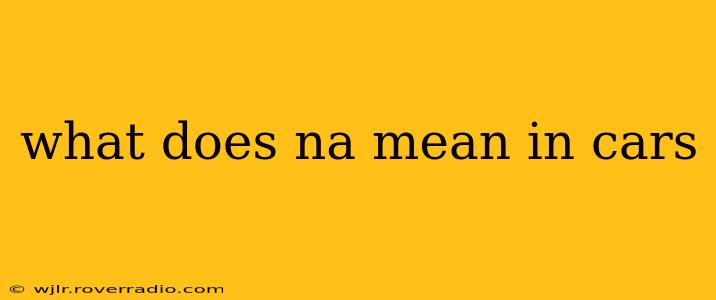The abbreviation "NA" in the context of cars typically stands for Naturally Aspirated. This refers to an internal combustion engine's method of air intake. Understanding what this means is crucial for appreciating the differences in engine performance and characteristics.
What is a Naturally Aspirated Engine?
A naturally aspirated engine relies solely on atmospheric pressure to draw air into the combustion chamber. There's no forced induction—no turbocharger or supercharger—to compress the air before it mixes with fuel. The air is drawn in by the downward stroke of the piston, creating a vacuum that pulls in the air-fuel mixture. This process is entirely driven by the engine's own mechanics.
How Does NA Differ from Turbocharged or Supercharged Engines?
The key difference lies in how air is delivered to the cylinders. Let's compare:
-
Naturally Aspirated (NA): Atmospheric pressure alone fills the cylinders. This results in a smoother power delivery, often with a more linear power band. However, power output is generally lower for a given engine displacement compared to forced induction systems.
-
Turbocharged: Uses a turbine powered by exhaust gases to compress incoming air. This increases the density of the air-fuel mixture, leading to significantly higher power output. However, turbocharged engines often exhibit turbo lag—a delay between pressing the accelerator and feeling the power—and can feel less smooth at lower RPMs.
-
Supercharged: Employs a belt-driven compressor to force air into the cylinders. Similar to turbocharging, this leads to increased power, but supercharged engines typically offer better responsiveness than turbocharged engines because there's less lag.
What are the Advantages and Disadvantages of NA Engines?
Advantages:
- Simplicity and Reliability: NA engines are generally simpler in design and have fewer moving parts. This translates to greater reliability and often lower maintenance costs.
- Smooth Power Delivery: The power delivery is typically smoother and more linear across the RPM range.
- Higher Revving Capabilities: NA engines can often rev higher than their forced induction counterparts, leading to a more engaging driving experience for enthusiasts.
- Better Sound: Many enthusiasts appreciate the natural, often higher-pitched sound of a naturally aspirated engine.
Disadvantages:
- Lower Power Output: For a given engine size, NA engines produce less power than turbocharged or supercharged engines.
- Less Fuel Efficiency (in some cases): While this isn't always the case, some NA engines can be less fuel-efficient than comparable forced induction engines, particularly under heavy acceleration.
What Cars Typically Use NA Engines?
Many sports cars, particularly those emphasizing high-revving performance and driving experience, still utilize NA engines. However, the trend in recent years has shifted towards turbocharging and supercharging for improved fuel economy and power output across the power band. You'll find many smaller displacement engines, or engines in vehicles prioritizing fuel economy, also employ NA technology.
Is NA Better Than Turbocharged or Supercharged?
There's no single "better" option. The optimal choice depends entirely on the vehicle's intended purpose and the priorities of the manufacturer and driver. NA engines offer simplicity, smoothness, and a distinct driving feel, while forced induction systems deliver higher power and often improved fuel efficiency. The best engine type depends on balancing factors like power, fuel economy, cost, and driving experience.
What does NA mean in terms of horsepower?
NA doesn't directly translate to a specific horsepower figure. Horsepower is determined by many factors, including engine size, design, and technology, with NA simply indicating the type of engine. A larger-displacement NA engine will generally produce more horsepower than a smaller-displacement NA engine, but it will still likely produce less power than a smaller-displacement turbocharged engine.
